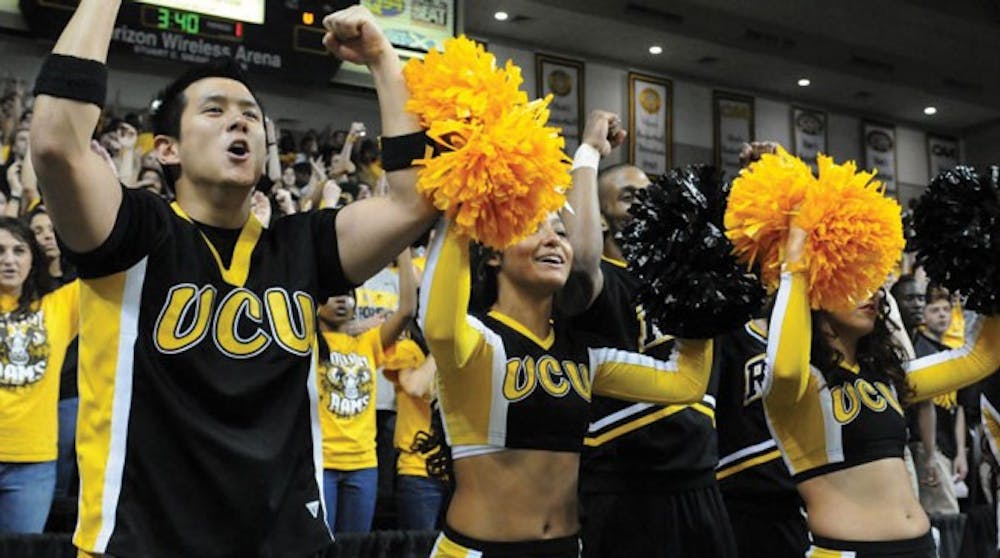January 2011. Alex Wu rubbed his hands together in the winter air as he walked into a cheer gym, warming up for an intense night of tumbling. As he rushed up the steps to the gym, pumped with adrenaline, he had no idea that he would injure his ankle that night. A year later Wu, a Virginia Commonwealth University cheerleader, USA All-Star cheerleader and coach at Platinum Cheer Stars in Petersburg, Va., still hasn't recovered.
Mid-April 2011. Emma Aycock stares at her feet on the tumble track, a long, rectangular trampoline, moments before throwing her pass. She begins her full, a tumbling feat in which she twists her body upside down high off the ground, full speed, and lands on her feet. Only she lands off the tumble track, on the floor, with her weight on her rolled ankle. Little did she know, she had just torn three muscles and the ligament away from the bone in her leg.
Pause. A crash course in Cheerleading Terminology for Dummies: Tumbling is a part of cheerleading in which the athlete performs acrobatic flips in the air. There are two types: standing and running. Standing tumbling is when the athlete does the stunt from a standstill position. Running tumbling, often referred to as a pass, is when the athlete gains momentum by beginning with a round-off, similar to a cartwheel but with more force, and follows up with several back handsprings into the final stunt. These stunts range in difficulty: back-handspring, back tuck, layout, full, double. Play.
July 2010. Andrew Pa and his stunt group attempt to throw their flyer into the air, far above their heads. She shoots up, gathering momentum on the way down. In these split seconds, Pa braces himself to catch his flyer, noticing her elbows are sticking out. In a blink, Pa has a ripped eyelid. "I had five stitches across my eyelid, four stitches going into my eye socket and I almost tore my tear duct," he said.
But these cheerleaders don't stop to recover. Wu sums up the sentiment best: "I refuse to rest."
Pa, a freshman cheerleader at James Madison University, still practiced with the stitches in his eye even though doctors told him not to. "Cheerleading is one of those things when you're injured you still want to do because you want to be with everybody else," he said. Aycock, a senior cheerleader at Hayfield Secondary School in Northern Virginia, initially thought her injury was just an ankle sprain. In October, she had an MRI that revealed its true severity. Despite this, she has been on it all season. "I didn't really see the point in giving up when I had been practicing this long with the injury," she said.
During Wu's senior year at Langley High School, his stunt group was working on a scorpion double down, a stunt in which the flyer stands on one foot, pulls the other up behind her to touch her head, and then spins twice on the way down. As his flyer spun twice, her elbows opened out and hit Wu on the nose. "I felt my nose starting to get warm and so I immediately cupped my hands under my nose and it literally bled a whole puddle in my hands. It actually overflowed and I ran to the trainer and let all the blood out there. I had to get my nose reset."
Wu has broken his nose seven times from cheerleading; enough times that he now has his own home remedy: "What I do is I get two pencils. I stick the pencils into both nostrils and I pretty much jam [them] up there and try to fix my nose myself."
The injuries don't stop there.
Statistics from the American Association of Neurological Surgeons show in 2009 an estimated 10,223 cheerleading-related head injuries were treated in U.S. emergency rooms. From 2005-2008 the National Center for Catastrophic Sport Injury Research recorded incidents such as when, "a female cheerleader was practicing a new stunt with her squad, standing in an extension on her partner's arm when she fell and landed on her head. She suffered a fractured skull and was on a ventilator for 12 hours." In tumbling, ankles, knees, the lower back, meniscus, ACL and MCL all get torn easily, Wu said.
So why are cheerleaders getting injured faster than you can say ra-ra-shish-koom-ba?
Perhaps pressure is the cause of some injuries. Hayfield Secondary School varsity cheerleading coach, Lynn Hendricks, said that she understood why her own high school coach had pressured her. When Hendricks tried out for the varsity squad in high school, she threw a round-off back-handspring, for tryouts. But during the season she refused to do it. Finally her coach gave her a choice. "The choice was either do it or I'm off the team," Hendricks said. "I finally did it because I was more scared of not being on the team than falling when I tumbled. I was perfectly capable of doing it. It was just a mental block."
Enjoy what you're reading?
Signup for our newsletter
Wu said coaches who did not fully teach something before cheerleaders try to do it were a cause of injury. "Coaches can be more certified and knowledgeable when teaching kids. They need to make sure that kids know the fundamentals before pushing other skills. The biggest example is high school. Most high school coaches don't know what they are doing and a lot of injuries happen in high school cheer," he said.
Yet Aycock didn't feel as though coaches were to blame. She said her coaches had explained the safety issues and risks well. "Injuries have always resulted from either accidents or just a lack of paying attention on the part of the athlete," she said.
Blame the coaches or athletes, the true cause of the injury may just be the difficult nature of the sport itself.
Wu said that cheering was a combination of acrobatics, dance, and gymnastics. "It's only two minutes and 30 seconds. Those two minutes and 30 seconds aren't even like sprinting for two minutes and 30 seconds, because every time you do [the routine] it gets harder and harder. You can do a routine 10 times and you can come in first the next day. It still won't be easy because you can always tumble higher, you can always make your pop higher, you can always jump higher so you'll never get used to it. It's extremely difficult," he said.
"The best representation of what cheerleaders nowadays do is when they show the national competition on ESPN. I've sat there and watched them with my husband, and he doesn't know too much about cheerleading, but he's definitely impressed. He can tell how great of athletes these gentlemen and ladies are just by watching their competition," Hendricks said.
But what the television doesn't show are the difficulties that injured cheerleaders face. Aycock said the most difficult part of cheering was coming back after an injury. "You get to a certain point before and then you get pushed back so far. You have to build from the basics again. You have to get back to where you were, but then you have to strive to be even better than you were," she said.
Today, Aycock is still not at 100 percent. She said: "[With] the extent of the injury that I have I probably won't ever fully recover from it, but I think I can definitely deal with. I get used to it a little more everyday."
So why do these Energizer-Bunny cheerleaders keep going past the pain? Because cheering is awesome, Wu said. "I enjoy it too much. Two weeks without cheering and I feel uncomfortable. I enjoy it so much I just want to do it at least three or four times every week or even more. I love cheering everyday, and I just don't want to rest."
Rewind. September 2007. A stunt group is at a practice, nearing their competition. They are putting together their pyramid sequence, in which all the stunt groups on the team connect holding one another up. One group runs into place with their flyer held in their hands by their chests. They go up; they bring her back down, causing her head to collide on the girl standing in front of her. She bites down on her tongue so hard its gushing blood. The coach runs over to see if she is OK, flinching as she looks inside her mouth.
I was that flyer.
Fast-forward. At a USA All-Star cheer practice on Dec. 4, 2011, a cheerleader named Dylan O'Connel got hit on the nose when his flyer elbowed him as she fell in a stunt. O'Connel was grounded. His coach came over to see whether he was all right, but O'Connel wouldn't get off the floor. He picked up his head and his teammates made faces in horror: the bridge of his nose was a sick, purplish-blue hue, blood pouring from it. What did O'Connel look like 30 minutes later? With two paper towel "plugs" in his nostrils, he was flipping full force through the air with everyone else.
Contact Marina Askari at marina.askari@richmond.edu
Support independent student media
You can make a tax-deductible donation by clicking the button below, which takes you to our secure PayPal account. The page is set up to receive contributions in whatever amount you designate. We look forward to using the money we raise to further our mission of providing honest and accurate information to students, faculty, staff, alumni and others in the general public.
Donate Now



